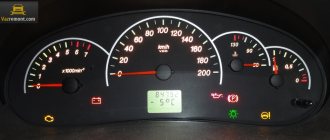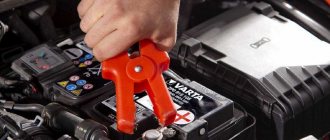22.10.2019
| (Votes: 1, Rating: 5) |
Issues discussed in the material:
- How does the battery warning light work?
- Why is the battery light on?
- Why doesn't the battery light come on?
Every car owner from time to time carries out diagnostics of his car to identify problems. Nowadays it becomes almost impossible to do this, especially while driving. The testing tools are becoming increasingly scarce. For example, voltmeters are no longer installed on the instrument panel, and problems with charging can only be recognized after notification of the warning lamp. In this article we will tell you why the battery light on the instrument panel is on.
How does the battery warning light on the dashboard work?
When the driver inserts the key into the ignition, the red battery light on the panel lights up. Then the engine starts and the icon goes out. This should be normal, the battery indicator lights up until the moment when the internal combustion engine starts working.
During this period of time, when the ignition is turned on, but the engine has not yet started, self-diagnosis of the car systems occurs before the engine starts. In addition to the battery light, other indicators also light up. After checking, some of them go out almost immediately, the rest turn off after starting the internal combustion engine. If everything is in order with the battery, then when the engine is running, it is charged, and the icon on the panel lights up for a few seconds and then goes out.
In another way, the design of the warning light can be described as follows: the ignition is turned on, then voltage is supplied through the fuse to the battery on the dashboard.
The current then passes through the diodes, relay controller, brushes, slip ring and winding. After starting the internal combustion engine, the voltage is equalized at the lamp terminals and the icon goes out. At the same time, the battery is charged. If there is any malfunction in the car system, the battery light does not go out after checking or its icon periodically appears on the dashboard.
The operation of the control lamp is tied to the generator, although it is a separate element. The system is quite simple. Two electrical circuits are connected to the battery light.
This diagram looks like this:
- Lamp - fuse box - ignition - generator - battery.
- The generating device is a control lamp (the connection is made directly).
The operation of the battery depends on the voltage at both inputs. If the current flows the same way, the battery light goes out, and if it flows differently, it lights up. This explains why two circuits must be connected.
How it works. The driver turns on the ignition. In this case, the first circuit receives current from the battery to the lamp, but in the second there is no voltage from the generator, because the engine is not running yet. The red indicator on the instrument panel lights up. After this, the car owner starts the engine, the generator starts working, and voltage appears in the second circuit. The light goes out. At the same time, current from the generating device also begins to flow into the first network.
When the battery light comes on, the car system checks whether everything is OK with charging and whether there is voltage. Some people believe that at this moment a complete diagnosis of the car occurs before starting the engine, but this is not so.
We recommend
“Normal car battery voltage: numbers that need to be memorized” Read more
If the generator breaks down while driving, voltage stops flowing to the second circuit.
Charging comes only from the battery in the first circuit. The red warning light icon appears on the panel again.
After starting, the battery indicator on the VAZ Priora lights up
VAZ (Lada) Priora 2007 - present
When I start the car, the battery indicator on the instrument panel lights up, when I give gas the indicator goes out. What is the reason? How to fix?
- The new generator sags under load in the Priora - 1 answer
- Battery lights up on devices in Priora - 5 answers
- No charging at idle - 4 answers
- Stalls after starting Priora - 4 answers
- What is the charging rate for the VAZ 2110? – 4 answers
If the battery indicator is on, this means that the battery is not being charged from the generator. And if the light goes out when the engine speed increases, then the most likely reason is that the generator brushes are worn out, that is, they have become short and in order for the brushes to be attracted to the rotor, more current is needed, that is, just an increase in engine speed.
In the future, this trick will no longer help; you need to change the brushes. Also check the “grounds” on the body and on the engine. And all the contacts on the generator.
Why is the battery light on?
The car battery and alternator are closely related. To start the engine, current from the battery goes to the starter. After this, the voltage begins to come from the generator, which is powered by a running engine.
The battery is charged from the generator. The higher the engine speed, the higher the voltage that comes from the source. To prevent overcharging and the current level is not too high, a relay regulator is installed on the generating device.
The main function of the relay regulator is to maintain optimal voltage on the battery, since the current supply does not depend on the number of engine revolutions.
The battery light on the dashboard is most often due to the fact that the battery is not receiving charging from the generator. That is, the car is started from the battery, the internal combustion engine starts to work, but the icon does not go out.
Breakdowns that occur most often:
- malfunction of the relay regulator;
- failure of the diode bridge;
- the alternator belt is broken, poorly tensioned or slipping;
- severe play in generator bearings and wedging;
- blown fuses;
- poor contacts at the battery terminals, at the generator output, on the ground wire;
- generator circuit open;
- wear of generator brushes or brush holders;
- problems with the ignition switch.
We recommend
“How long to charge a car battery” More details
When the battery light comes on on the panel while the engine is running, first check the charge level at the battery terminals. Diagnostics can be done quickly; a multimeter is used for this. Normally it should be 13.5-14.3 V. If no current is supplied, the voltage will be 12V.
For a more thorough check you will need: a knife, pliers, flat and Phillips screwdrivers, a 12V test lamp, a multimeter, fine sandpaper.
Troubleshooting
We figured out why the battery light is on. And when the causes are identified, you should begin to eliminate them:
- charging the battery will help restore its functionality if it is weakened due to long-term operation of electrical appliances with the engine turned off;
- Only a specialist can repair internal damage to the battery;
- loosening of the belt or its rupture can be eliminated by adjusting its tension or completely replacing it;
- oxidized terminals should be cleaned with fine-grained sandpaper;
- brushes and generator wires must be replaced;
- breakage of the generator winding, rotor wear and other serious defects, as a rule, precede the replacement of the unit on the recommendation of a specialist.
Cleaning the Battery Terminals
Listen to your car while driving and pay close attention to the dashboard readings. These simple steps help identify problems with your car at an early stage, which will help you avoid more serious consequences in the future.
You can share your personal experience of “eating” with the battery charging light on in the comments below the article.
Source
Reasons why the battery light is on
The first option is that current is supplied from the generator, the voltage is 12V at the battery terminals, the battery is discharged. In this case, you need to strip the terminals and wires. After this, you need to measure the voltage level again. If this method does not help, check the charging at the terminal of the generating device. Attach one multimeter probe to it, and the second to ground. If the voltage is higher than that of the battery, you need to clean the generator terminals. In addition, it may be necessary to replace the cable from the alternator to the battery.
The second option is that the battery is discharged, the current level on the battery is 14V, but it drops under load. This situation is possible due to problems with the pulley, poor tension of the generator belt, wear or breakdown of its bearings.
The reasons may also include problems with the diode bridge. The failure of even one diode can lead to voltage failures. Therefore, you need to check its condition. Also in this situation, the stator winding should be diagnosed. To do this, you need to turn off the ignition and check the generator, its diodes and other elements with a multimeter. At the same time, the generator brushes are checked. They must be at least 5 mm. If the length is shorter, they will need to be replaced.
A blown fuse can also cause the battery to stop receiving charge. As a rule, this is F10 with a rating of 10 A. The problem in most cases is solved by replacing it. Malfunctions may also be in the relay or ignition switch. To diagnose, you need to ring with a multimeter.
Sometimes it happens that the devices work after turning the key in the ignition, although they are not charging. This can be solved by removing the wire from the terminal of the generating device and connecting it to the body or minus. If the battery light is on, then the cause is a malfunction of the generator excitation winding.
Poor contact in the battery connector can also cause the indicator light on the dashboard to light up. To prevent this problem from occurring, you need to clean all contacts and connectors. When the light shines weakly, intermittently, or does not light at all, then you need to look at other indicators. If all the icons are dim, the problem is not with the lamp. If only the battery indicator lights up poorly, this may be due to a malfunction of its contacts.
There are times when the battery light comes on after turning the key in the ignition, but then does not go out or blinks after starting the engine. The icon indicates that charging is intermittent or not charging. The most common cause is poor contact of the wire with the connector on the dashboard.
If you have carried out all the recommended checks, but have not been able to identify the cause, then you need to diagnose the relay regulator. To do this, current is supplied to the contacts, then its level on the brushes is checked. If the voltage is 12V, then the device is OK. Otherwise, the relay regulator must be replaced.
Useful tips
To prevent your car from having problems charging the battery, use the following tips:
- Don't ignore your car's dashboard signals. In this case, you will be able to solve the problem at the initial stage of its development.
- Inspect the alternator belt regularly. The correct operation of all electrical equipment on board directly depends on it. If there are any defects, replace it as soon as possible.
- Check the voltage from the generator to the battery. If you notice a discrepancy, diagnose the on-board network.
- Periodically pay attention to the condition of the battery terminals. If you notice oxidation, eliminate this defect. They can be treated with WD-40.
- Isolate the generator and battery from water to prevent short circuits. Leave engine washing to professionals.
- When repairing the battery charging circuit, do not use cheap spare parts.
To summarize, we note that the battery is the most important element in the car’s electrical network. Therefore, you should carry out timely maintenance of the charging circuit and, if necessary, change the necessary parts. In this case, you will ensure a proper system of work. In the article, we told you about the main malfunctions that can cause the battery charging lamp to light up and what to do about it. We hope our recommendations will help you in solving the problem at hand.
Source
Why the battery light may not light up when you turn on the ignition
We have looked at the reasons why the battery light comes on when the internal combustion engine is running. Now let's consider the opposite situation, when the light does not light up when the ignition is on and the engine is off.
- Battery is discharged
When the battery is discharged, the battery light stops lighting, the dashboard instruments do not turn on or glow dimly. To solve the problem you need to charge the battery.It is worth noting that sometimes the battery discharge may not occur because the driver forgot to charge it or did not turn off the headlights. The cause may be failure of the generating device. In this case, this problem becomes dangerous, since the battery is charged while the car is moving from the generator. If it breaks down, the battery will not charge.
We recommend
“Why the temperature light is on: reasons, possible consequences” Read more
- Battery light burns out
This is a typical situation. Over time, the indicators on the instrument panel burn out and are replaced with new ones.But if you do not change the light bulb in time, you may not notice the generator malfunction. Because of this, the battery may discharge at the most inopportune moment. For example, you went to the store, stopped, turned off the engine. Then you come back and the car won't start.
- Fuse failure
This is a fairly common reason why the battery light does not light up when igniting. When a fuse blows, it affects the operation of several components. The fuse is located in a “black box”, and on the mounting block there is a diagram showing how to find it.To easily check the fuse, replace it with a working device that you are sure is working. If all other devices and the light bulb start working, you need to replace it.
- Chain problems
Let's look at the main causes of problems with the circuit that powers the battery light bulb.The most common one is a problem with contacts. This mainly happens in spring. During the winter, moisture accumulates on the connectors, causing oxides to form. The contact is getting worse. This causes the warning light to stop turning on.
Typically, this problem does not occur immediately and is not permanent. The icon may or may not be on.
To fix this problem, you need to clean the connectors. A special grease is used for processing.
It happens that the circuit breaks, and the battery light may burn out because of this. You need to check the chain to identify the damaged area. Use a multimeter for diagnostics.
Another reason is a faulty relay. In some cars, the device is installed with control of the battery charge light on the dashboard. If the relay fails, the indicator will also not light up.
Diagnose relay problems with a multimeter. It is used to measure the current level at the positive output. If it is less than 6 V, then the problem is definitely in the generator. A higher value indicates a faulty relay. In this case, it will need to be replaced.
What do motorists think about the battery light?
- It's on and off If “it’s on and then off,” it’s a matter of contact. Vibration, heating. Check connections. Start with the instrument panel.
We recommend
“Icons on the car dashboard: explanation and nuances” Read more
- A special problem with brushes
Brushes can do more than just wear out. They may move tightly in the guide socket and become suspended at times. - Replacing the Generating Device
It is not enough to indicate only the series and body number when you are going to buy a generator. Some cars, even of the same year of manufacture, may have different generators installed: with a “simple” and a more “complex” integral. The latter are, of course, more expensive. - Generator location is important
Another possible reason is that the generator is installed too low. He draws salt and water onto the terminals. In cold weather, all this oxidizes well. The engine works - the generator heats up, when it doesn’t work - it remains cold.











